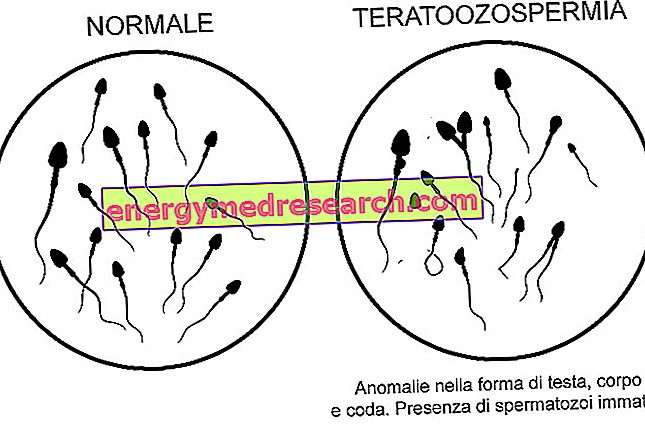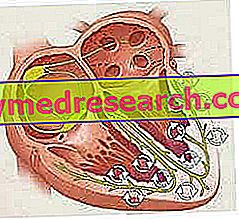Generality
Teratozoospermia is the condition suffered by men who produce sperm rich in malformed sperm .
A sperm in which spermatozoa prevail without malformations is essential for reproductive purposes; therefore, those suffering from teratozoospermia - especially when it is severe - do not succeed or experience severe difficulties in having children.

Among the causes and risk factors of teratozoospermia are conditions such as varicocele, genital infections, testicular cancer, testicular trauma, smoking, drug use, alcohol abuse, severe fever, treatments antitumor chemotherapy and radiotherapy, diabetes etc.
However, it should be pointed out that, in many situations, teratozoospermia is due to unknown factors.
To solve the problem of teratozoospermia, it is essential to treat the triggers, detected during the diagnosis.
Short review of what sperm are
Sperm are the male gametes, ie the cells that, in men, are deputies to the reproductive function, once they meet the female cells with the same task (egg cells).
Produced from the testicles (the male gonads ), on the occasion of the so-called spermatogenesis, the spermatozoa are very small cellular elements (5-7 micrometers, the diameter, and at most 70 micrometers, the length) and have a very particular structure, which includes :
- A head, containing the cell nucleus and acrosome ;
- An intermediate portion, rich in mitochondria;
- A tail, equipped with mobility and called a flagellum .
The particular morphology of the spermatozoa is fundamental for the reproductive process, as it allows them to meet and fuse with an egg cell, inside the female genital apparatus.
What is teratozoospermia?
Teratozoospermia is the name of an alteration of sperm, characterized by the presence of a large number of malformed spermatozoa .
Teratozoospermia is a condition of considerable interest among men wishing to have children, since a high number of malformed spermatozoa is associated with a decrease in male fertility ( male infertility ).
Definition of teratozoospermia according to the WHO
According to what was established by the World Health Organization (WHO) in 2010, a man suffers from teratozoospermia when, in the sperm produced following a classic ejaculation, spermatozoa with normal morphology are less than 4% .
Translated, this means that:
- A man with at least 4% spermatozoa with normal morphology cannot be considered affected by teratozoospermia;
- A man, in whose ejaculate the percentage of malformed spermatozoa is over 96%, is a carrier of teratozoospermia.
Curiously, before 2010, the WHO was of another opinion regarding teratozoospermia and believed, based on the medical knowledge of the time, that a male individual suffered from the aforementioned alteration of the semen when, in the ejaculate, the percentage of spermatozoa of normal morphology was less than 14%.
| Table . Reference values that sanction the normality of a human ejaculate, according to the latest indications from the WHO (2010). | ||
| Parameter | Unit of measure | Reference values |
| Ejaculate volume | Milliliter (ml) | > 1.5 ml |
| Sperm concentration | Millions per milliliter (Millions / ml) | > 15 million / ml |
| Total number of spermatozoa | Millions | > 39 million |
| Total sperm motility | % spermatozoa | > 40% |
| Progressive sperm motility | % spermatozoa | > 32% |
| Sperm vitality (viable spermatozoa) | % spermatozoa | > 58% |
| Spermatozoa with normal morphology | % spermatozoa | > 4% |
Epidemiology
Statistical data on the spread of teratozoospermia in the male population are indeed scarce. Moreover, the conduct of a study that evaluates, within a reliable sample, how many men suffer from the aforementioned sperm alteration is not at all easy; in fact, it would require a lot of time, money and availability from a large number of men (otherwise the statistics are not very reliable).
Synonyms
Teratozoospermia is also known as teratospermia .
Origin of the name
The words "teratozoospermia" and "teratospermia" derive from the union of two terms of Greek origin, which are:
- "Terato" from " teras " ( τέρας ), which means "monster", "deformed" or "bearer of deformity", and
- "Sperm" from " sperm " ( σπέρμα ), which means "seed".
Therefore, literally, teratozoospermia means "deformed seed" (where by semen is meant, obviously, the sperm and, specifically, the sperm population).
Teratozoospermia is added to ...
Teratozoospermia is just one of several sperm abnormalities that humans can suffer from.
In fact, there are also:
- Aspermia . It is the lack of production or sperm formation;
- Astenozoospermia ( astenospermia ). It is the small number of motile spermatozoa in the sperm;
- Azoospermia . It is the absence of spermatozoa in the sperm;
- Iperspermia . Indicates that the volume of sperm produced is abnormally high;
- Hypospermia . Indicates that the volume of sperm produced is abnormally reduced;
- Oligozoospermia (or oligospermia ). It is when there are few spermatozoa in the sperm;
- Necrozoospermia . Indicates the presence, in the sperm, of a conspicuous population of dead or immobile spermatozoa.
Causes
In most cases, teratozoospermia depends on unknown and unidentifiable causes; in the remaining circumstances, however, its trigger is recognizable and may consist of:
- Anti-cancer treatments such as chemotherapy or radiotherapy;
- Use of drugs that interfere with testosterone or GnRH (gonadotropin-releasing hormone) and, as a consequence, with the production of morphologically normal spermatozoa;
- A genital infection, that is an infection borne by one of those organs in which sperm and seminal fluid (prostate, seminal vesicles, epididymis and urethra) usually flow;
- Testicular trauma or testicular disease, such as testicular cancer or hydrocele;
- The varicocele. It is a pathological alteration of the testicular (or spermatic) veins, due to which the latter appear dilated and one or both testicles are swollen;
- Meningitis;
- Diabetes mellitus;
- A severe febrile condition or the after-effects of a serious febrile condition;
- Abuse of alcohol or illegal drugs (eg, hashish, marijuana, etc.);
- The smoke.
Curiosity
Teratozoospermia is one of the possible causes of asthenozoospermia, that is to say that sperm alteration characterized by the presence of a reduced number of motile spermatozoa.
This is not surprising, considering that the spermatozoa of a man with teratozoospermia can present malformations in the tail, ie the structure that allows them to move.
Symptoms and complications
Teratozoospermia is an asymptomatic condition, that is, it does not cause symptoms; this being symptom-free, however, does not exclude its possible association with a certain symptomatic picture, at a time when the problem is characterized by a typically symptomatic condition (eg: in men with a genital infection, an eventual teratozoospermia is added to disorders such as fever, burning during urination, foul-smelling urine, etc.).
Complications
As anticipated, teratozoospermia affects the fertility of a man and this can prevent the subject concerned from having children.
Curiosity: in how many couples unable to have children is male infertility responsible for this?
According to some statistical researches, 30-50% of couples wishing to have children, but unable to have children, owe this inability to a problem of male infertility; in other words, 100 couples who do not succeed in giving birth, despite the will, between 30 and 50 owe their lack of conception to insufficient human fertility.
When should I go to the doctor?
A man with teratozoospermia should contact a doctor, in this case a urologist or an andrologist, when:
- It is his intention to have children, but the alteration of the sperm he suffers is an impediment to this intention;
- It shows an associated symptom picture that drastically affects its quality of life. In such circumstances, the cause of teratozoospermia is a clinically relevant condition, which deserves the due attention and appropriate treatment.
Diagnosis
The diagnosis of teratozoospermia requires the performance of an examination known as a spermiogram .
The spermiogram is a laboratory investigation that allows to observe a series of important characteristics of a sperm sample, with the main purpose of establishing the degree of fertility of the "owner" man of the aforementioned sample.
Among the characteristics of the sperm, observed by spermiogram, are:
- Sperm viscosity,
- The sperm liquefaction,
- Sperm volume,
- The number and morphology of spermatozoa e
- Sperm vitality and motility.
Once the presence of teratozoospermia has been ascertained, the next step consists in searching for the causes responsible for the altered morphology of the spermatozoa; this research may require the performance of various diagnostic tests, including instrumental tests.
Basic rules for obtaining a reliable spermiogram
In order for the outcome of a spermiogram to be reliable, it is essential to comply with some preparatory rules for the aforementioned laboratory test; entering more into details, these preparatory rules are:
- Complete abstinence from sexual activity for 3-5 days prior to the exam;
- Ejaculation obtained exclusively by masturbation;
- Before masturbation, provide adequate hand and penis hygiene;
- Provide for the collection of all the sperm produced (therefore including the one for which it is necessary to press the penis, after the main emissions);
- Collect in a clean place;
- For collection, use a suitable and sterile container (eg: urine containers);
- Close the used container tightly, so as to avoid accidental loss of the collected sperm sample;
- After collecting the sperm sample, send it to the testing laboratory as soon as possible (within 30-60 minutes), avoiding thermal shocks. To simplify everything is the now increasingly common possibility of collecting the spermatic sample directly in a bathroom of the analysis laboratory;
- Inform the medical staff of the laboratory of any therapies or diseases followed or occurred in the last three months;
- Inform the medical staff of the laboratory of any failure to comply with one of the aforementioned preparatory standards, in order to understand whether it is necessary to repeat the semen sample collection procedure.
What should a normal sperm be like?
A sperm is morphologically normal when:
- The head is oval, is between 5 and 10 micrometres long, and its main components (cell nucleus and acrosome) are well distinguishable from one another;
- The intermediate portion is linear, opposite to the acrosome and at least one and a half times longer than the head;
- The tail is the leanest part of the entire male gamete, it is no less than 50 micrometers long and proves to be mobile.
Examinations for the investigation of the causes of teratozoospermia
The search for the causes of teratozoospermia always starts from the objective examination and from the anamnesis ; therefore, also on the basis of what emerged from these two tests mentioned above, it can continue with: a blood and urine test, a spermioculture, an ultrasound of the testicles, an ultrasound of the lower abdomen etc.
Therapy
Teratozoospermia therapy focuses on the treatment or elimination of the causative factor ; clearly, such an approach (treatment of the triggering factor) is possible when, at the origin of the sperm malformation, there is a clearly recognizable cause.
Example of treatment of teratozoospermia due to a clearly recognizable cause
In men with teratozoospermia due to a genital infection, it will be the latter's cure that represents the remedy against the high number of morphologically abnormal spermatozoa.
Natural remedies against teratozoospermia: healthy and balanced diet
According to several experts, it would be beneficial to men with teratozoospermia - as it would improve the quality of spermatogenesis - a healthy and balanced diet, which gives ample room for the consumption of fruit and vegetables (both sources of antioxidants) and that of foods rich in omega-3 (ex: fish).
Teratozoospermia, infertility and assisted reproduction in vitro
For some time now, men eager to have children but unable to have them because they have teratozoospermia can count on a particular in vitro assisted reproduction technique, known as ICSI or intracytoplasmic injection .
Without going into too much detail, the ICSI provides for the specific collection, from a sample of ejaculate, of spermatozoa with normal morphology (as well as mobile, vital, etc.), the selection of one of these and its inoculation, in vitro, in an egg cell (which, of course, belongs to the partner of the "owner" of the ejaculate sample).
Currently, ICSI is one of the most effective non-conventional IVF techniques that can be used by men with teratozoospermia problems and desiring paternity.
Prognosis
Teratozoospermia is reversible, as long as the triggering condition is recognizable and treatable.



